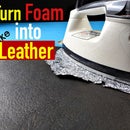Introduction: Make a Guitar Pickup From an Old Watch
A while back, I was looking to add a pickup to an old guitar I had picked up from a local thrift store so that I could amplify it. As the guitar wasn't worth much, I felt like spending a bunch of cash on a pickup was not justified. So I started to research how to make one myself.
Of course, there are many different styles of pickups available, all using different types of technology, but one of the simplest that I came across was made from piezo discs. Piezoelectric materials are substances that emit electricity when they are subjected to mechanical stress, and conversely, when electricity is applied to them, they change dimension. So, if you apply electricity, they will vibrate and create sound waves. Basically a super simple speaker. Pretty much any electronic device around your house that emits simple computery sounding beeps will likely have a piezo disc creating those sounds. Now, what happens if we induce vibrations into the piezo? The result will be an output of electricity that we can send down a wire to an amplifier, and voila, we have a microphone!
Most piezo's are stuffed somewhere in the internals of different devices, so I needed to find one that was easily accessible. Turns out that old digital watch with the broken strap fit the bill perfectly. The piezo is glued to the stainless steel backplate of the watch, which protects the piezo from breaking when being handled, and it is easily accessed just by unscrewing the back of the watch.
***Please note, This is all just my experimentation and I don't really know much about electronics so I take no responsibility for damages to any instruments, burnt fingers, electrocution, or any other possible horrible things that could happen because of doing this project. If you don’t know what you are doing, make sure you do your research first***
Supplies
An old digital watch with a metal back- preferably one that has little screws holding it on
A 1/4" mono audio jack and cable
Small screwdriver to open the watch
Rosin Flux Paste
Wire Strippers
Wire Cutters
Copper wire that fits tightly through the screw holes on the watch back
Soldering Iron
Electronics Solder
Anvil, or some sort of metal surface to hammer on
Hammer- a small ball peen hammer would be perfect, but use what you have
Step 1: Find Your Materials
I guess the first step is to find a broken watch you can give a new purpose in life to! You need a watch with a metal back, and it needs to be one that made beeping sounds when it was alive. Typically that means it is going to be a digital watch. I feel like the smaller piezo's gave a better sound than the larger ones, so if you have a choice, I'd go for a smaller watch.
The other important part is the cable. I had some old audio cables with 1/4" mono jacks on them so that is what I used. I'm certainly no electronics expert, but I think you want a cable that is shielded, in other words, there is one wire in the middle in a plastic sheath, and then the strands that make up the second wire actually wrap around the first wire. This is to prevent interference from other electrical devices.
Step 2: Do Some Simple Watch Surgery
Grab your little screwdriver and open up the back of the watch. The back should come off as a seperate piece. This is when you find out if you picked the right watch. If it has a whitish or silvery disk glued to the back, you have just unearthed a piezo disc! You can see the disc on this watch has a crack in the coating on top of the piezo. I wasn't sure if I should use it or not, but I gave it a try anyways, and it worked out O.K. But normally there wouldn't be a crack on it:)
Step 3: Stick Some Wire in a Hole
Stainless steel is a great material for a watch back because it is strong and doesn't corrode like many other metals. It also doesn't like to let solder stick to it. That is a problem for us, because we need to get the electrical signal from the back of the piezo disc which is bonded to the stainless watch back. In order to solve this problem, I used a small piece of copper wire (which loves being soldered to) to create a mechanical connection to the stainless back.
Take a piece of copper wire and push it through one of the screw holes in the watch back. It needs to be close to a perfect fit, so you might need to scrounge around a bit to find the right wire. I had some copper wire laying around, I don't know what it came from, but it was just a tiny bit too thick. I used a file to file away a little bit of the wire until I could jam it in the hole.
Once the wire fits the hole, cut it off so that just a millimeter or so protrudes from each side.
Step 4: Do Some Riveting
In order to keep the tiny piece of copper wire secure in the hole, it needs to have both ends mushroomed out so that they are larger than the diameter of the hole. This is where you will get very frustrated if your wire is too thin for the hole.
You will need a metal surface on each side of the copper wire in order to effectively mushroom it. I have my grandfather's anvil, but you could use a flat part of a vise, or even another hammer held in place.
With one side of the watch back flat on the anvil, gently tap on the end of the copper wire, slowly mushrooming the end. Once one side is nicely mushroomed, flip the watch back over and mushroom the other side. One side is going to be trickier than the other, as it has a raised lip. I just held it so the raised part was hanging over the edge of my anvil while I hammered it.
If your hammer is rusty, like mine was, make sure to clean the top surface of the copper wire so that the solder will adhere properly. I gave it a quick run across with my file to clean it up.
Step 5: Make Some Solder Blobs
Okay, here's the trickiest part of this project. You need to get a blob of solder to stick to the top of the piezo disc. The piezo disc is covered with a super thin layer of some sort of conductive metal, but it is so thin, that if it gets too hot, it will peel away from the disc with your solder.
So, in order to have the best chance of getting a good bond, use some flux on the spot where you are going to solder, make sure your soldering iron is up to temp, and then add solder to the tip of your iron to create a little blob on it. Then just quickly touch the piezo disc where the flux is and pull the soldering iron away, hopefully leaving a nice little blob of solder behind.
If you mess up and the solder doesn't stick and removes some of the coating, don't worry, you can try again in another spot on the piezo disc, and it should still work.
Also make a blob on the top of the copper wire. Do this the same way, but you can take your time, because there is no surface to worry about.
***I do not have a lot of experience soldering, so if you aren't sure what you are doing, please look up some instructional videos. Also make sure you have researched the proper safety precautions when using solder. Some solders have lead in them, and the fumes can also be harmful, not to mention there is a risk of burning yourself**
Step 6: Strip the Wires
Strip the wires back on the end of the cable you are using. Do your best not to cut through the thin copper wires that surround the center wire when you are stripping them. Gather all the surrounding wires together and twist them to make one twisted wire.
Strip about 2mm at the tip of the center wire.
Step 7: Check the Placement
Hold your cable up to the watch back. The smaller center wire will be soldered to the blob on the piezo disc, and the thicker wire will be soldered to the copper post.
You will likely want to trim the twisted wire down so that it can be soldered to the post without a lot of extra wire hanging around.
Tin both wires. This is just adding solder to each wire before you solder the wires to the watch. To do this, flux the wires, and then hold the soldering iron on one side of the wire and the solder on the other and let the heat from the soldering iron draw the solder through the wire.
Step 8: And Do the Final Solder
Now solder the wires to the watch back. One to the piezo, and one to the copper stud.
Again, be careful to be as quick as possible when attaching the wire to the blob on the piezo disc.
Step 9: Stick Some Blue Sticky Putty to the Back and Stick It on Your Guitar
The pickup is now complete! Now it is just a matter of sticking it to your guitar and plugging it in to a recording device or amplifier. For quick temporary placement, I used blue sticky putty. I just used a small amount and then pressed it lightly onto the guitar with a slight twisting motion.
**Make sure the sticky putty is not going to harm whatever instrument you are using and be careful not to push too hard so you don't break any fragile surfaces**
Because this simple mic is picking up the vibrations directly from the instrument surface, where it is placed makes a big difference to the sound. I found I had the best result placing the pickup on the bridge. Out of necessity, I put it on the lower side of the bridge so it would be less in the way of the strumming hand.
Step 10: Expand Your Horizons!
Obviously, this mic is not just limited to guitars, pretty much anything that vibrates can be amplified with this little device. I took it to a recording studio and Rusty Matyas recorded an amazing song using only this device to capture all the sounds. It really blew my mind. You can check that song out in the video above.
Thanks for hanging out with me!
If you'd like to see more of my projects you can find me here:
Subscribe to my YouTube Channel: https://goo.gl/v5clos
Follow me on Instagram: https://goo.gl/v5clos
Check out my pattern shop: https://goo.gl/v5clos

Participated in the
Reuse Contest













